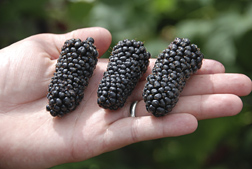Two New Berries for You from ARS
 By Sharon Durham
By Sharon DurhamSeptember 28, 2016
Agricultural Research Service (ARS) geneticist Chad Finn and his colleagues at the Horticultural Crops Research Unit in Corvallis, Oregon, developed two new berry varieties—a blueberry and a blackberry—and recently released them to the public.
Baby Blues, a blueberry cultivar, is a vigorous, high-yielding, small-fruited, machine-harvestable highbush blueberry with outstanding fruit quality. It is well suited for processing markets that require a small fruit size. Baby Blues should offer growers and processors an alternative to the low-yielding Rubel highbush blueberry, and it should thrive in milder areas where northern highbush blueberries are grown, according to Finn.
Baby Blues made its debut during the 100th anniversary of the first cultivated blueberry crop to go to market. This new blueberry was released in cooperation with the Oregon State University's Agricultural Experiment Station and the Washington State University's Agricultural Research Center.
Up until the early 1900s, blueberries were picked from the wild, and the bushes often did not survive when transplanted. True domestication was beyond reach until 1910. That was when U.S. Department of Agriculture (USDA) botanist Frederick Coville discovered that blueberry bushes require moist, acidic soil to thrive. In 1916, exactly a century ago, the first commercially cultivated crop of highbush blueberries was harvested.
Finn also developed a new blackberry named Columbia Giant. This thornless, trailing blackberry cultivar is a high-quality, high-yielding, machine-harvestable blackberry with firm, sweet fruit. The fruit quality is similar to or better than that of the industry standards Marion and Black Diamond. Due to its extremely large size, Columbia Giant will mostly be sold in the fresh market. It also is adaptable to areas where other trailing blackberries thrive.
Columbia Giant came from the same breeding program as Baby Blues and was also released in cooperation with the Oregon State University's Agricultural Experiment Station.
Read more about this research in the September 2016 issue of AgResearch.
ARS is USDA's chief in-house scientific research agency.

No comments:
Post a Comment